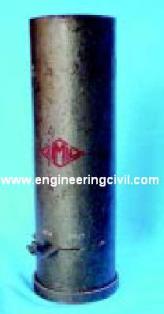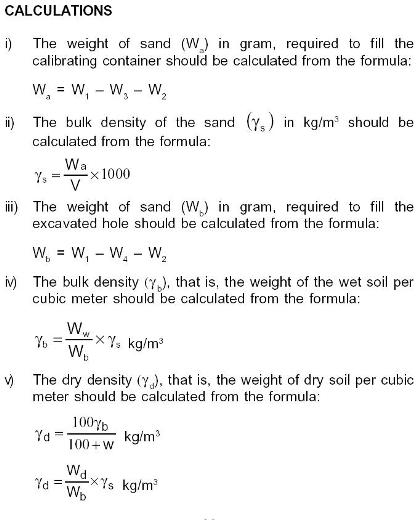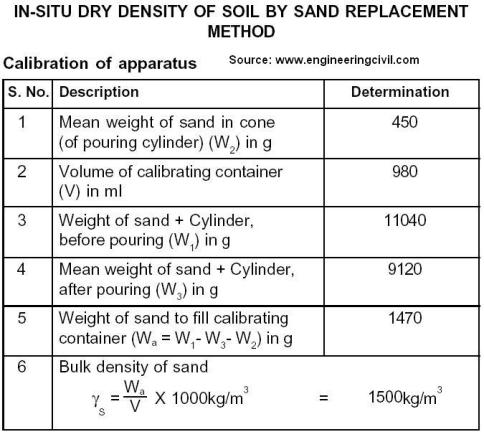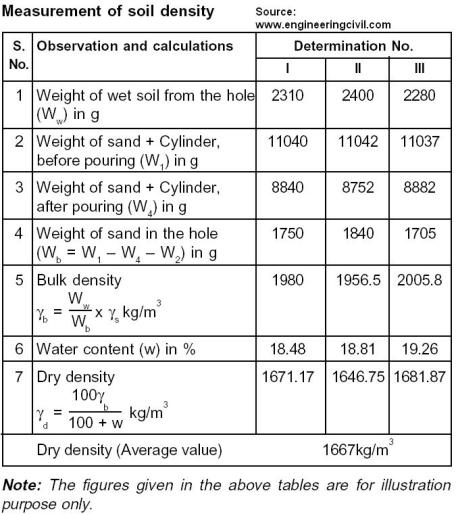This test is done to determine the in-situ dry density of soil by sand replacement method as per IS: 2720 (Part XXVIII) – 1974. The apparatus needed is
i) Sand-pouring cylinder conforming to IS: 2720 (Part XXVIII) -1974
ii) Cylindrical calibrating container conforming to IS: 2720 (Part XXVIII) – 1974
iii) Soil cutting and excavating tools such as a scraper tool, bent spoon
iv) Glass plate – 450mm square and 9mm thick or larger
v) Metal containers to collect excavated soil
vi) Metal tray – 300mm square and 40mm deep with a 100mm hole in the centre
vii) Balance, with an accuracy of 1g

Procedure To Determine The In-Situ Dry Density Of Soil By Sand Replacement Method
A. Calibration of apparatus
a) The method given below should be followed for the determination of the weight of sand in the cone of the pouring cylinder:
i) The pouring cylinder should be filled so that the level of the sand in the cylinder is within about 10mm of the top. Its total initial weight (W1) should be maintained constant throughout the tests for which the calibration is used. A volume of sand equivalent to that of the excavated hole in the soil (or equal to that of the calibrating container) should be allowed to runout of the cylinder under gravity. The shutter of the pouring cylinder should then be closed and the cylinder placed on a plain surface, such as a glass plate.
ii) The shutter of the pouring cylinder should be opened and sand allowed to runout. When no further movement of sand takes place in the cylinder, the shutter should be closed and the cylinder removed carefully.
iii) The sand that had filled the cone of the pouring cylinder (that is, the sand that is left on the plain surface) should be collected and weighed to the nearest gram.
iv) These measurements should be repeated at least thrice and the mean weight (W2) taken.
b) The method described below should be followed for the determination of the bulk density of the sand ( Ys ):
i) The internal volume (V) in ml of the calibrating container should be determined from the weight of water contained in the container when filled to the brim. The volume may also be calculated from the measured internal dimensions of the container.
ii) The pouring cylinder should be placed concentrically on the top of the calibrating container after being filled to the constant weight (W1). The shutter of the pouring cylinder should be closed during the operation. The shutter should be opened and sand allowed to runout. When no further movement of sand takes place in the cylinder, the shutter should be closed. The pouring cylinder should be removed and weighed to the nearest gram.
iii) These measurements should be repeated at least thrice and the mean weight (W3) taken.
B. Measurement of soil density
The following method should be followed for the measurement of soil density:
i) A flat area, approximately 450sq.mm of the soil to be tested should be exposed and trimmed down to a level surface, preferably with the aid of the scraper tool.
ii) The metal tray with a central hole should be laid on the prepared surface of the soil with the hole over the portion of the soil to be tested. The hole in the soil should then be excavated using the hole in the tray as a pattern, to the depth of the layer to be tested upto a maximum of 150mm. The excavated soil should be carefully collected, leaving no loose material in the hole and weighed to the nearest gram(Ww). The metal tray should be removed before the pouring cylinder is placed in position over the excavated hole.
iii) The water content (w) of the excavated soil should be determined as discussed in earlier posts. Alternatively, the whole of the excavated soil should be dried and weighed (Wd).
iv) The pouring cylinder, filled to the constant weight (W1) should be so placed that the base of the cylinder covers the hole concentrically. The shutter should then be opened and sand allowed to runout into the hole.The pouring cylinder and the surrounding area should not be vibrated during this period. When no further movement of sand takes place, the shutter should be closed. The cylinder should be removed and weighed to the nearest gram (W4).
CALCULATIONS

REPORTING OF RESULTS
The following values should be reported:
i) dry density of soil in kg/m3 to the nearest whole number; also to be calculated and reported in g/cc correct to the second place of decimal
ii) water content of the soil in percent reported to two significant figures.
A sample proforma for the record of the test results is given below.


If you have a query, you can ask a question here.



Thank you civil engineering portal. its very helpful site for all civil engineers.
Tanx it’s a 1daful web site, keep it up.
please different for astm method and IS method . give to astm method procedure and calculation format fiven for you
it is a wonderful web site, very educative .
Hi HOW CAN WE CALCULATE CYLINDER CONE FOR SAND REPLACEMENT METHOD FOR SOIL FIELD DENSITY